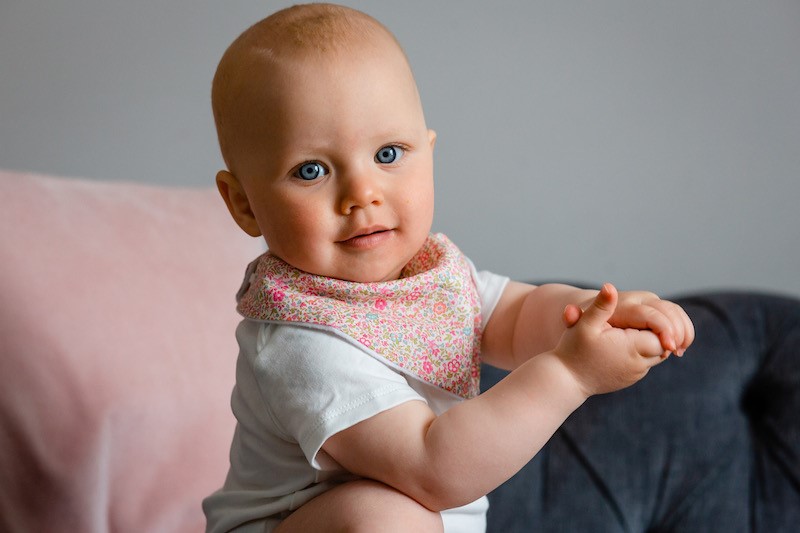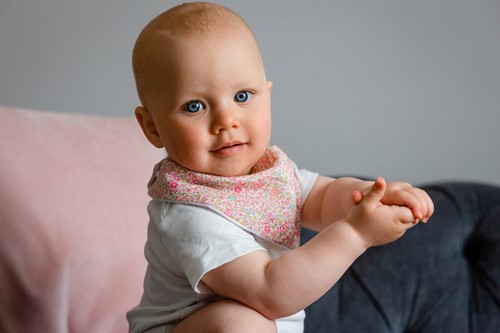A baby’s first teeth (known as milk or deciduous teeth) usually develop before birth. These teeth then start to emerge through the gums when a child is six to nine months old. This is known as teething.
When teeth emerge through the gums they do not cut through the flesh. Instead, special chemicals are released within the body that cause some cells in the gums to die and separate, allowing the teeth to come through.
How long does the teething process take?
A baby’s bottom front teeth usually come through first, followed by their top front teeth (central incisors) and then the top and bottom incisors either side (lateral incisors).
The first molars (back teeth) then start to come through at approximately 12-14 months of age, followed by the canines (next to the lateral incisors) at 16-18 months, and finally the second molars at 18-30 months. A child will normally have a full set of first teeth by the time they are two-and-a-half to three years of age.
In a small number of cases, some children may be born with one or two teeth that have already come through, or will have a tooth emerge within the first few weeks of birth. This should not cause a child any problems, unless it affects their feeding. Some parents notice changes in their baby’s health during teething. While many doctors are divided on which are teething symptoms and which are due to other things, diarrhoea, drooling and a runny nose can be indications of teething. However, most physicians believe that a runny nose and drooling aren’t really teething symptoms, but due to bacteria and excessive chewing that babies do while teething.
You may notice that your baby has a decreased appetite during teething. This isn’t due to intestinal distress, but pain from chewing or even sucking on a bottle teat. Cold foods like yogurt or apple sauce can be good choices for teething babies.
However, there are lots of ways you can help make teething easier for your child. Every child is different, and you may have to try several treatments until you find one that works for your baby.
Teething gels
Teething gels such as Bongela often contain a mild local anaesthetic which helps to numb any pain or discomfort caused by teething. They may also contain antiseptic ingredients, which help prevent any sore or broken skin in your baby’s mouth becoming infected.
You will need to gently rub the gel onto your baby’s gums using a clean finger. Always follow the instructions which come with the gel.
Teething rings
Teething rings give your baby something to safely chew on, which may help to ease their discomfort, as well as providing a distraction from any pain.
Some teething rings can be cooled first in the fridge, which may help to soothe your baby’s gums. You should follow the instructions which come with the ring so you know how long to chill it for. You should never put a teething ring in the freezer, as if the teething ring becomes very hard or cold, it could damage your baby’s gums.
You should also never tie a teething ring round your baby’s neck, as it may be a choking hazard.
Chewing
One of the signs that your baby is teething is that they start to chew on their fingers, toys, or other objects they can get hold of. Sophie la Giraffe is a recommended toy for this.
Try and give healthy things for your baby to chew, such as raw fruit and vegetables. For example, pieces of apple and carrot are often ideal. Unsweetened rusk biscuits are also a good option. Make sure you always supervise your child when they are eating.
Painkilling medicine
If your baby is in pain, or has a raised temperature, you may want to give them a painkilling medicine which has been specifically designed for children. These medicines normally contain a small dose of analgesic (painkilling medication), such as Paracetamol, to help ease any discomfort. The medicine should also be sugar-free.
You must always follow the dosage instructions which come with the medicine. If you are unsure, please ask the pharmacist.
Cool drinks
Cool, sugar-free drinks will help to soothe your baby’s gums, and may also help if they are dribbling excessively. The best option is to give them cool water – just make sure it is not too cold.
Comfort
Comforting or playing with your baby can sometimes help to distract them from the pain in their gums. It may be that your baby is feeling too irritable or restless to play, but at other times, it may be a good way of getting them to concentrate on something other than their teething pain. Taking baby for a walk in the pram can also help as a distraction. They love to be in the open air and see the outside world.
Preventing rashes
If teething is making your baby dribble more than usual, make sure you frequently wipe your baby’s chin and rest of their face. This will help to prevent them developing a rash. Dribblebuster bibs are useful for this as they fit closely to the neck and absorb the dribble, but make sure they have a soft backing to avoid irritation and are thick enough to absorb the moisture.
bibs are useful for this as they fit closely to the neck and absorb the dribble, but make sure they have a soft backing to avoid irritation and are thick enough to absorb the moisture.
